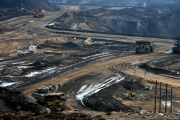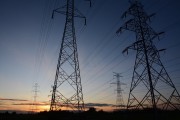If you’re renting a house to a tenant who smokes, ensuring that you have a working smoke alarm might seem like basic due diligence — especially if the neighbours have told you repeatedly that they’ve seen flames and smelled smoke coming from the unit. But you’re unlikely to stop there — you’d probably demand some changes from the renter in order to prevent your asset from going up in smoke.
The Government of Canada is now facing a similar situation following its announcement of plans to implement a comprehensive monitoring system to measure the environmental impacts of oilsands development.
Make no mistake: This is a positive news story. Over the past year, independent scientists and multiple review panels have been scrutinizing oilsands monitoring processes, and they have all come to a similar conclusion: Current monitoring is insufficient, and, in the case of water monitoring, is seriously flawed and unreliable. There is clearly a need for a major overhaul of oilsands monitoring to inform regulatory enforcement and responsible decision-making. The fact that the federal government has finally stepped up to the plate suggests that it is making some progress in recognizing its responsibilities in the oilsands.
However, let's be honest about what this plan is, and what it is not. At this point, the Government of Canada has produced a plan that is based on sound science, and that should (hopefully) increase transparency regarding the environmental impacts of the oilsands. As such, it appears to be a substantial improvement over the current approach, in which industry leads monitoring in an ineffective, patchwork manner. This plan does not mean, however, that the environmental issues related to the oilsands have been solved — and it is certainly not a "green plan." In and of itself, it does nothing to address the environmental impacts of the oilsands; it just identifies them.
Several questions remain: How will the new monitoring system be implemented? Who is going to pay for the new system to ensure its operation over the long term? (There appears to be a misunderstanding between Environment Minister Peter Kent and the oilsands industry on this question.) And, most importantly, how are the regulators going to use this new information to better enforce environmental laws? While collecting information is important, monitoring without adequate regulation, sufficient enforcement, and informed decision-making is a meaningless effort.
For more than 40 years, oilsands development has been rapidly expanding with little attention paid to addressing the cumulative impacts of all of these projects — despite the fact that independent scientific studies have been showing clear evidence of environmental damage. Even though rules have not yet been put in place to protect species at risk and water quality, or to set real limits on greenhouse-gas pollution, the governments of Canada and Alberta haven't hesitated to approve new projects. Apparently, both are satisfied by the industry's claims that there are no significant environmental impacts, using data from monitoring processes now deemed seriously flawed. But there doesn't appear to be any appetite to revisit past regulatory approvals, or to adjust or suspend the review of proposed projects.
Credible monitoring is required to inform management and answer tough questions like: How much oilsands development is acceptable, and what environmental standards should governments set? It is certain that more environmental impacts will be detected if the government starts seriously looking for them, but it must also be ready and willing to act.
To show it is serious about listening to science, the Canadian government could start by pausing approvals for new projects until the appropriate data has been collected and understood. Unfortunately, it appears that some bureaucrats in the governments of Alberta and Canada think a new monitoring system is little more than a public-relations device that provides justification for continued oilsands expansion. Furthermore, ministers in both governments have made a number of unfortunate statements about how new monitoring measures will "prove" the oilsands are responsibly managed. Such comments suggest that the root of the problem remains: There is an unwillingness to accept scientific data if it interferes with business-as-usual oilsands development.
If governments are serious about achieving responsible oilsands development, they will require much more than a long-overdue monitoring system; the newly available information must be used to establish science-based environmental limits. Going forward, responsible development requires a strict commitment from the regulators to ensure that all oilsands developments meet these rules.
While we commend the Government of Canada on finally committing to install an oilsands "smoke alarm," Canadians need to know if the government will heed the call to action when the alarm sounds. Canadians can't be assured that the oilsands are being developed in an environmentally responsible manner until monitoring systems lead our government to address the impacts, including the ones we know about today.
If this progress is to serve the interests of environmental protection, and not just public relations, the government owes it to Canadians to be transparent about how environmental monitoring will lead to effective environmental management.





